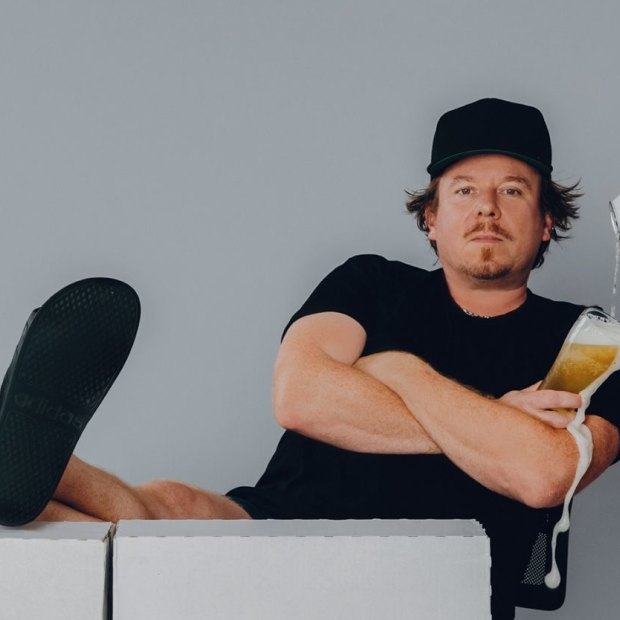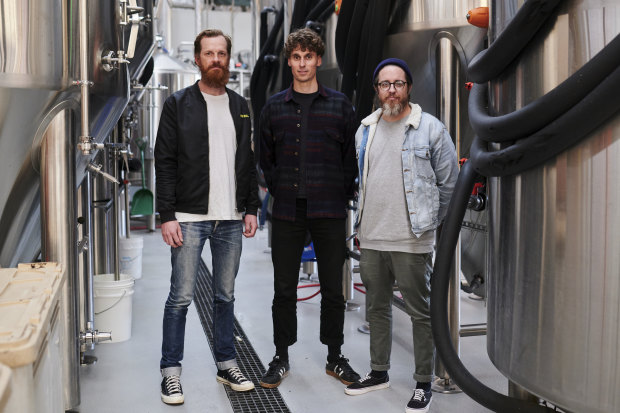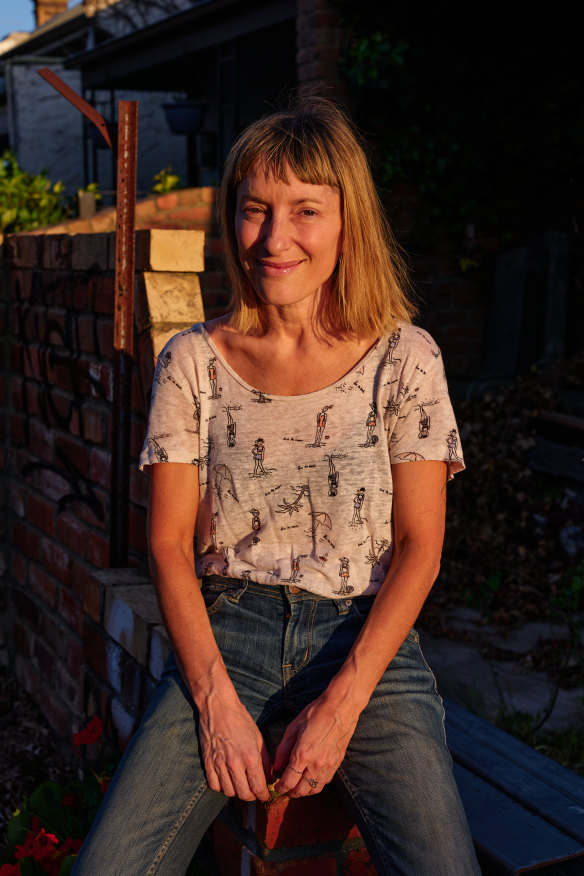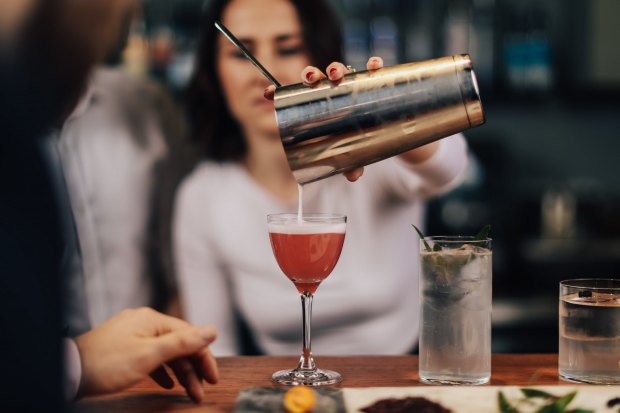This was published 4 years ago
True brew: the beer tapping into the booze-free boom
For a long time everyone agreed: low-alcohol beer tasted terrible. But rising sales are turning that assumption on its head – and riding the new sobriety movement in the process.

Drinks writer Mike Bennie likens the growing popularity in non-alcoholic drinks to choosing free-range over cage-farm eggs at the supermarket.
Last summer, frustrated with my fluctuating schedule as a freelance writer, I got a job at my local wine store. This isn’t any workhorse corner bottle-o; Blackhearts & Sparrows in Melbourne’s Collingwood
is like a booze boutique, stocking some of the most interesting wine, beer and spirits being guzzled by the discerning punters of the inner north. But after the binge season of Christmas and New Year, I noticed customers being drawn to one area of the fridge: the non-alcoholic section. It seemed this was no longer an embarrassing graveyard for watery substitutes, but a genuine movement. Viable, delicious alternatives for “the drink you have when you’re not having a drink” were now among the store’s most in-demand items.
Blackhearts boss Paul Ghaie confirms the store has seen more than 200 per cent growth in “non-alcs” this financial year, and he’s not alone. Endeavour Group, the company behind liquor giants BWS and Dan Murphy’s, also confirms its sales of non-alcoholic drinks have more than doubled, increasing by 100 per cent in the 12 months to May, with beer being the biggest non-alc sub-category. While this category was valued at $4.5 million nationally in the 2020 calendar year, it’s expected to jump to $15 million in 2021, according to retail data analysts IRI.
It’s a trend we’re seeing around the world, according to James Atkinson, the host of Aussie booze podcast Drinks Adventures. “Non-alcoholic beer in particular has been massive in Europe for a long time,” says Atkinson. “In recent years everyone has jumped on the bandwagon, but I am yet to be convinced that the market justifies the number of products coming out at the moment.”
All the major players have their hand in the non-alcoholic beer category, including Carlton & United Breweries, which has brewed one million cartons of Carlton Zero since launching the spin-off in 2018. CUB says its non-alcoholic beer sales have since multiplied 80 times, with 27 per cent of its beer portfolio now zero-, low- or mid-strength beer.
“It will be interesting to see how many of the new products still exist in five years’ time,” says Atkinson. “CUB claims to have sold 3.2 million litres of Carlton Zero in its first 12 months, yet the Australian beer market produces 1.7 billion litres each year. That’s just 0.18 per cent of the market, and they would probably spill more Carlton Draught on the ground than that. It’s definitely a trend, but still very early days.”
At Blackhearts, Australian-made 0.5 per cent alcohol beer Heaps Normal has seemingly come from nowhere to become the store’s top-selling beer. The sleek cans of “Quiet XPA” – a tropical-style extra pale ale – are spruiked as “too good to be wasted”, and sell twice to three times the volume of any other full-strength beer, including Coopers, Peroni or craft darling Balter.
“We’re always trying to predict the next big thing, but this is one we didn’t see coming at all,” says Blackhearts’ beer buyer Cherry Murphy. “We’ve stocked one or two non-alcoholic beers in the past … but Heaps Normal is the first that made me think, ‘I’d drink this myself.’ The way people are drinking and the whole beer culture has really changed.”
I meet the Heaps Normal co-founders at an alarmingly cool warehouse office filled with gold records and gig posters near the Corner Hotel in inner-city Richmond. The team works from desks at the Unified Music Group whenever they travel to Melbourne to brew a new batch. It’s a fitting location, as Andy Miller, Peter Brennan and Ben Holdstock look more like members of an indie band than fledgling businessmen. The ultra-friendly, super chill blokes are bearded, beanied and bespectacled, and perhaps not who you might picture to lead a movement into mindful drinking.

Heaps Normal founders Andy Miller, Ben Holdstock and Peter Brennan.Credit: Rohan Thomson
Heaps Normal is a relative babe on the crowded beer market, launching in July 2020 – at the tail end of Dry July and in the midst of a global pandemic. Its founders estimate they’ve doubled production every other month since launch, and say the brand now has 600 stockists around the country struggling to keep up with demand for the hoppy concoction you’d swear was full strength.
“It’s been overwhelmingly epic for us to see that we’re outselling ‘normal’ beers,” says Brennan. The South African, who moved to Australia 10 years ago, has never had a good relationship with alcohol – he lost his father, a drinker, to suicide at the age of 11. “I found I’d avoid social situations because I didn’t want to answer the question, ‘Why are you drinking a Coke?‘,” he says. “Or I’d go out and behave like an idiot, get drunk and be ‘that guy’ again. But I’ve got two kids now, and that made me realise I wanted to do something about it.”
Brennan approached several heavy-hitters in the beer industry with his elevator pitch: a low-alcohol beer that looks and tastes like the real thing. “It’s fair to say they would politely laugh me out of the room,” he says. Eventually he contacted Andy Miller, a friend who’d worked as head of marketing for successful Sydney-based indie beer company Young Henrys. “Straight away, Andy just got it,” Brennan says. “Then we had to figure out how to actually make the beer.”
“I found I’d avoid social situations because I didn’t want to answer the question, ‘Why are you drinking a Coke?’ ”
Miller instantly thought of Ben Holdstock, aka “Nice Ben”, a talented brewer who had worked up the ranks at boutique Aussie brewers such as 4 Pines and The Grifter, as well as Young Henrys. Holdstock spent the next few months cooking up different brews in his kitchen in Sydney’s Marrickville before hitting pay dirt.
“We use a slightly different process to the traditional methods,” says Holdstock of his recipe. “We don’t actually remove any alcohol: we use a few process tweaks and special yeast strains to produce a trace amount of alcohol, which we believe leaves a lot more flavour in the beer.”
Making the frothy amber liquid was a challenge, as many alcohol-free beers suffer from tasting watered-down or light to the point of flavourless. “We overcame this by balancing the lack of alcohol with a complex carbohydrate profile [a blend of malted barley, wheat and hops] to give it the same mouth-feel as a full-strength pale ale,” Holdstock says. “The actual ingredients are the same as any other beer.”
The product is made in Melbourne, utilising staff and equipment from Dandenong brewery Brick Lane. It’s a business born in the age of Zoom: CEO Miller, 39, is based in Canberra, while head of brand Brennan, 40, and head brewer Holdstock, 37, are based in Sydney.
A fourth business partner, international surfer Jordy Smith, a childhood friend of Brennan, is based in Los Angeles. After several early conversations (at the pub, of course), they realised they all had different reasons for wanting to reduce their alcohol consumption. “The drinking culture in Australia means you go out and end up surrounded by alcohol, and it just becomes a habit,” says Miller. “I have a young family as well, and I was reflecting on those habits thinking, ‘Why am I having a beer?’ And I didn’t have an immediate answer.”
After creating the prototype brew, Heaps Normal packaged its first batch of 1200 cans for friends and family. “It was just unmarked silver cans with a sticker on it; my wife, my kids and I were putting the stickers on by hand in a production line,” says Brennan.
Feedback was positive: they even did blind taste-tests with restaurant sommeliers, quizzing them on what they thought the ABV (alcohol by volume) was.
“They all said ‘Three per cent, Four per cent?’ When we said it was non-alcoholic, people’s jaws hit the floor,” says Brennan. Next, they hit up bars and bottle-shop owners directly. “We presold 75 per cent of the first batch before it even landed in the market, just from the three of us calling people around the country from our living rooms,” says Miller.
As the business plan took shape, they received a development grant from the Canberra Innovation Network, which led to being selected for the Startmate Accelerator program as one of 16 rising start-ups chosen from 480-plus applicants. The Shark Tank-esque boot camp led to a $1.3 million funding injection from a group of angel investors, including Adore Beauty, Culture Amp, Airtree Ventures and Linktree – allowing them to produce 60,000 empty cans and officially begin production.
The pandemic pushed the launch date back several times, causing them to question whether COVID-19 would end the business before it started. “But while hospitality took a massive hit, the retail sector continued to be strong,” says Miller. “And people were seeming to reassess their relationship with alcohol while being locked at home, so we realised there was an opportunity to play a part in solving this problem for people.”
Heaps Normal now has three full-time staff in Melbourne, four in Sydney and two in Canberra. Its second beer, the limited edition Isol-Aid Haze IPA, launched last month as a collaboration between Blackhearts and Isol-Aid, an online streaming festival started in lockdown by musician and music promoter Emily Ulman. It’s a good match, Ulman says, as Heaps Normal and Isol-Aid have a similar brand ethos. “We’re both very DIY, with a punk mentality and the idea that anyone can do something awesome,” she says. Music and alcohol go hand-in-hand, from bands getting wasted on riders, to venues relying heavily on alcohol sales, but Ulman says the industry is primed for change.

A tragic event turned Emily Ulman towards alcohol-free options.Credit: Simon Fazio
“There’s this idea that booze and music are synonymous, but a lot of people slip through the cracks.” In August 2020, Ulman lost a close friend to alcohol-related health issues. Mike Noga was the drummer for rock band The Drones, who died from a cerebral haemorrhage exacerbated by bouts of heavy drinking.
“Mike had a lifelong struggle with anxiety and depression, which became particularly difficult in the last three years of his life,” Noga’s family wrote in a statement, released in April.
“Being on the road constantly made it difficult for Mike to get professional help … often it was all too easy to self-medicate with alcohol in order to board a flight, get through a gig or to deal with stress in general.”
Noga’s death hit Ulman hard, and she’s been reaching for alcohol-free alternatives ever since. “It makes it so much easier that there are products out there that taste like beer so you can have the same endorphins and still feel smug the next day,” she says.
Researching this story, I seemed to get an email every day plugging a new non- or low-alcoholic product. Business is booming. I go to the launch of Brunswick Aces, an entire bar dedicated to non-alcoholic drinks in Melbourne’s trendy Brunswick East. Leading non-alc spirit brand Lyre’s, based in Sydney’s Leichhardt, trumpets its value at more than $179 million. Australia’s first alcohol-free bottleshop, Sans Drinks, opens in Sydney’s Freshwater. And a new beer called ONE, a 500ml can of lager that amounts to one standard drink, offers the expertise of cardiologist Dr Ross Walker as spokesperson for its product.
Walker insists many Australians don’t even know what a standard drink is. “I saw a patient today who said, ‘I only have three drinks a day’, but he’s talking about three-quarters of a bottle of wine,” he says. “That’s not three standard drinks – a standard drink of wine is about 100ml. A lot of people have a can of beer, which is usually around 4.8 per cent alcohol, without realising that that’s 1.4 standard drinks.”
The National Health and Medical Research Council insists we should have no more than 10 standard drinks a week, but Walker thinks 14 drinks is a more reasonable target.
“If you can’t go a day without drinking, you’ve got a problem with alcohol.”
“I say to people, ‘Have at least one day a week off alcohol.’ Not because there is any major health benefit from doing that – but just to prove to yourself that you can. If you can’t go a day without drinking, you’ve got a problem with alcohol.”
Drinks writer and Sydney bottle-shop owner Mike Bennie says many people think of him as a “piss warrior” who is constantly “in a fog”. In fact, he’s strict with how much alcohol he consumes, particularly when tasting up to 60 wines a day in his job as a drinks critic. “I take substantial abstinence periods to reset my body from the fun park I sometimes treat it like,” says Bennie.
The day we speak is his 10th day off drinking for the month. Bennie’s in-the-know bottle shop, P&V, has locations in Newtown and Paddington. The No. 1 selling beer in his stores right now is, you guessed it, Heaps Normal, which outsells the 50 other beers in the fridge. Bennie likens the boom to choosing free-range over cage-farm eggs at the supermarket.
“People are making decisions about how they consume, and part of that is looking after one’s health and wellbeing,” he says. “There’s a lot of inspiration from those who are fit, look well, eat well, drink well. And the non-alc category has risen in tandem with these concepts of wellness.”
Some may think such drinks are designed for those trying to cope with alcoholism, but that’s not the case. A beverage that tastes alcoholic could actually be a trigger, says UK-born, New York City-based writer Ruby Warrington, whose hit book and podcast Sober Curious has been part of the growing global movement to question alcohol consumption.
“There’s a lot of inspiration from those who are fit, look well, eat well, drink well. And the non-alc category has risen in tandem with these concepts.”
“In some sober recovery circles, these kinds of drinks can be frowned upon, because they are seen as potentially a gateway to having a ‘real drink’, ” says Warrington. “But for people who don’t identify as being in recovery, they are potentially life-saving … Being able to hold a beer that looks and smells and tastes like beer can have a really great placebo effect, not just on you but on other people in the group as well.”
Fellow podcaster James Atkinson says there’s been a noticeable shift in the way younger people view alcohol. “Those who are newly of drinking age are all on social media, and may have a fear of getting pissed and making a dickhead out of themselves online,” he says. “They’re also seeing what someone who has been drinking for their whole adult life looks like, and that’s not a very desirable image.”
Warrington agrees, and thinks there’s the potential for drinking to one day be viewed like smoking. “Fifty years ago, it was cool to smoke, and there were adverts around it being a stress reliever – now it’s dead uncool,” she says. “You see statistics of Gen Zs not even drinking in the first place, because it’s uncool and they don’t want to be out of it.”

Melbourne’s Brunswick Aces bar has 100 non-alcoholic beers, wines and cocktails on its menu.Credit:
The Heaps Normal lads take me for lunch at a nearby taco restaurant, Fonda, which is known for selling bright buckets of beer to rowdy tables.
Fonda recently started selling Heaps Normal for $8 a can – cheaper than most beers, but pricier than a soft drink. Yet not every venue has been so receptive to stocking a product that could discourage customers from getting hammered.
“Some venues and individuals see non-alcoholic beer as a threat, and they get quite agitated about it,” says Miller. “They say, ‘What’s the point?’ But it’s an interpretation I struggle to empathise with because it’s just another option. If someone’s not drinking, and they’re coming to your venue, they’re not buying beer anyway. We’re just providing that person with an opportunity to be part of a social situation that they wouldn’t otherwise be part of.”
“We’re not saying don’t drink. We’re saying find your own normal.”
While Miller and Holdstock still drink alcohol, Brennan says he’s probably drunk “more than anyone else in the room” in his lifetime, and has been teetotal in recent months. “We don’t preach sobriety, we’re not saying, ‘Alcohol is the devil, don’t drink.’ We’re saying find your own normal.”
Next on their agenda is to build a dedicated Heaps Normal brewery, which they hope to open by the end of the year. “Sydney, regional NSW and ACT are all options we’re considering,” says Miller. “It’s such an involved process, because it’s important for us to find the right site – place is such an important part of beer.”
They plan to stay independent, and would love to see Heaps Normal become the first non-alcoholic beer poured on tap in Australia.
“There’s a few hurdles to overcome when pouring in taps,” says Holdstock. “One of those is that it freezes really easily because there’s no alcohol in it. Dispensing beer in long lines overnight could very well make a beer slushie … which could be cool, but we have to work out a better way to do it.” Miller throws down a challenge: “If we’re not the first, we’d love someone else to beat us to it. It would be a great thing for the industry.”
The impact of their success has hit home at different times. For Miller, it was hearing about a woman who was able to keep her pregnancy secret from her friends for longer as she could still “drink”. Holdstock mentions a bloke in his 80s, told by his doctor he could no longer drink, who is still able to join his mates for a beer every afternoon. Brennan tells me about a group of teenagers – 18 or 19 years old – buying four-packs at their local bottle shop. “The owner thought it was her duty to call out that they were buying non-alcoholic beer,” he says. “But they said, ‘We’re landscape gardeners, we’ve got to be up early tomorrow to go for a surf before work, and this is what we want.’ All these little stories make us high-five each other.”
I finish another taco and drain my third can as our meeting draws to a close. I feel like we’ve just had a rollicking, boozy lunch, and I’m at the tipping point where I’d usually be looking for another drink – the stronger the better. Instead, I jump in my car and drive, my head as clear as glass, my hands steady on the wheel.
To read more from Good Weekend magazine, visit our page at The Sydney Morning Herald, The Age and Brisbane Times.
The best of Good Weekend delivered to your inbox every Saturday morning. Sign up here.